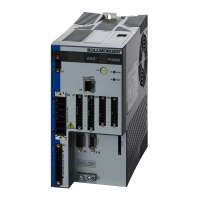AKD User Guide | 12 Creating Motion
12.1 Homing
12.1.1 Overview
Homing is used to mechanically move a motor (connected to a mechanism) to a specific location on the
machine, referred to as “home”. Motion tasks then use this home as a reference point for movements that must
base a known position on this reference point. Motor movement is usually controlled by a variety of limit
switches (end of travel) and a home reference switch. Using these reference points with the logic of the drive
allows the machine to find and set the home reference point.
12.1.2 Using Homing
The AKD includes a variety of homing methods (set with HOME.MODE) to accommodate your machine needs:
l Home using current position (HOME.MODE 0)
l Find limit input (HOME.MODE 1)
l Find input limit then find zero angle (HOME.MODE 2)
l Find input limit then find index (HOME.MODE 3)
l Find home input (HOME.MODE4)
l Find home input then find zero angle (HOME.MODE 5)
l Find home input then find index (HOME.MODE 6)
l Find zero angle (HOME.MODE 7)
l Move until position error exceeded (HOME.MODE 8)
l Move until position error exceeded, then find zero angle (HOME.MODE 9)
Each of these homing methods offers a different way to achieve a home reference point based on your particular
system mechanics. All homing methods provide the options of adjusting the acceleration, deceleration, and
speed for homing moves. In addition, once the homing move is completed, you can either set an offset position
or make an offset move as required. Homing modes, guidance for mode selection, and homing examples are
included in 12.1.2.2 Selecting and Using Homing Modes
Note: When using any of the methods that use homing switches and limits, please refer to the Input/Output sec-
tion for proper wiring techniques.
12.1.2.1 Home Default Window
The Home window provides a means to select your homing method and configure the homing settings. This win-
dow also provides a simple controls to start homing and confirm homing success.
120 Kollmorgen | December 2010

